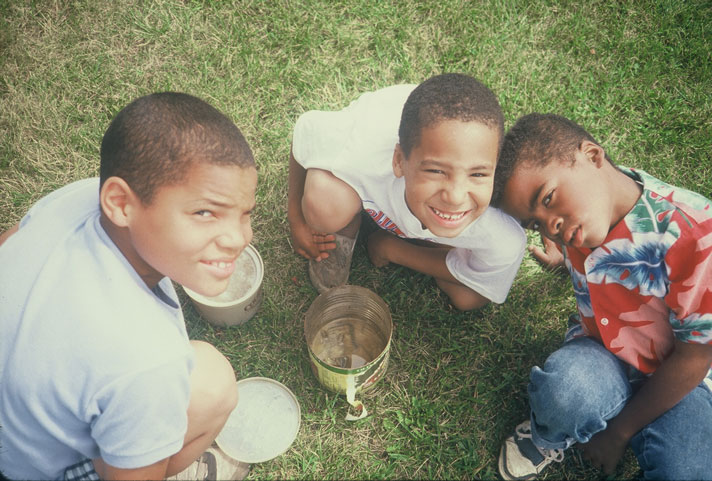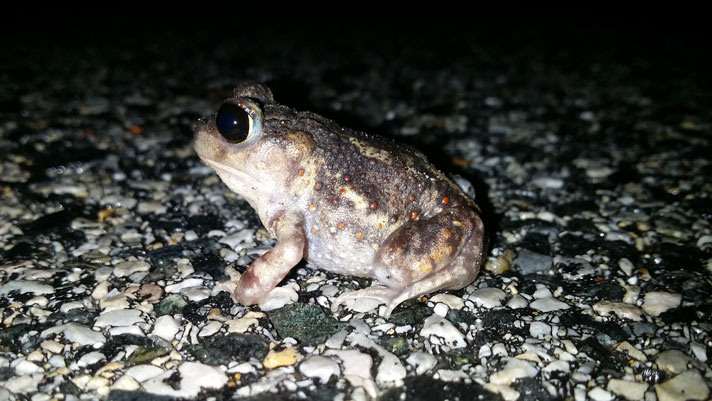It took the author several decades to finally find his holy grail of herps, an eastern spadefoot toad.
Growing up I had the classic existential field herper problem: I lived in the suburbs (an area light on the herps) and couldn’t drive. But I could read. As a 9-year-old—we’re talking the 1980s here—I had an impressive shelf of herp literature: National Audubon Society Field Guide to Reptiles and Amphibians of North America, that iconic green, an odd-shaped volume with color photos of herps in the first third and text info in the rest, with the all-important distribution maps. I had various iterations of Peterson guides with the intriguing drawings. There were the regional field guides; books specifically on frogs or snakes or turtles; and the thin books you could purchase in pet stores on the care of a certain species. I even possessed several fat herp encyclopedias, replete with information on field herping and pet care.

Benjamin Baker
It took the author several decades to finally find his holy grail of herps, an eastern spadefoot toad.
My parents were very supportive of my hobby/obsession. In our basement—which was partially subterranean and always dark—I maintained several enclosures. I kept the standards of the day (green treefrogs, fire-bellied toads and newts, African clawed frogs, pickerel and leopards, bullfrogs and green frogs) as well as some unusual and high maintenance pets. For my 10th birthday my parents surprised me with an Argentine horned frog (aka the Pacman frog), back then a whopping $50! This I kept in my room in a terrarium with a polished gravel floor, a hollowed out log for cover, a bed of moss, and a sunken water dish. To my mom’s chagrin, I initially fed it frozen baby mice, and then live white mice. Heaven!
The highlights of my life was going to “the field.” The more pedestrian, but still exciting, trips, were to Greenbriar or Catoctin State Park (we lived in Maryland). The crème de la crème of herping trips was on the very rare Sunday (once or twice a year) when my father took me to a friend’s property far out in the sticks (it’s a subdivision now, a full-on suburb of Washington and Baltimore). Literally, we would drive along a gravel road with tree limbs thwacking the side of our car. Many times the road itself would yield a kingsnake, racer, or garter, or a fleeting raccoon, possum, groundhog, or skunk (but this is about herps). Our destination was two large ponds, replete with cattails, lily pads, algae and moss, with dragonflies swooping about and water spiders skating on the water’s surface. Surrounding the ponds was a dense forest generously padded with decaying leaves, hundreds of bark bits and logs begging to be rolled, vernal ponds, and gooey marsh. The enchantment of hearing the bullfrogs call loudly, and just the possibility of what was in the vicinity made these trips nothing short of magical for me.
I had other herping outlets. Our family would do road trips and the occasional plane or cruise, and I could get some field herping in then—I remember my excitement at seeing an iguana in the Bahamas. There was also Boy Scouts. But this wasn’t enough—I could never hope to see a fraction of the herps in the books on my shelf.
I believe one of the biggest lures of herpetology is the mystery, the elusiveness of the creatures. I’ve sometimes wondered how this plays out in today’s world, with the instant gratification and access of the internet, being able to view endless photos and videos, and indeed purchase, nearly any herp you want. But then again, today there are less wild spaces, and those that are wild tend to be maintained and altered, closed at night with officers patrolling. Anyhow, when I was coming up, the rarer and more far-flung the herp, the better. But there was always that one species that was in your range, yet you had no idea how to encounter it. For me, this was the eastern spadefoot toad (Scaphiopus holbrookii).
Remember the photos of these guys in the guides? Huge, bulging eyes; plump; warty, yet with frog-like smooth, moist skin; spaded hindfeet; unique patterns—they were like aliens. And they were within my range, the gray of the map flowing over the entire state of Maryland! But the spadefoot’s habits would make it virtually impossible for me to see one: “extremely fossorial,” “spends most of its life buried underground,” “emerges only on warm nights after heavy spring rains.” And their habitat? A word that I kept coming across was “loam” or “loamy areas.”
What was “loam?”
This was back when if you wanted to know the meaning of a word, you had to look it up in a physical book. This is Webster’s entry for loam:
“a rich, friable soil containing a relatively equal mixture of sand and silt and a somewhat smaller proportion of clay.”
Well, this only made the obscure eastern spadefoot even more fascinating. Everywhere I’d go I’d try to determine if the soil was loamy. Sand on the beach sort of matched the description, but I couldn’t imagine a spadefoot around the crowds at Ocean City or Myrtle Beach. So you’d see me far away from the waves, on the periphery, rooting around for a spadefoot. Of course, in my desire to find one, I forgot the other conditions: on warm nights after heavy spring rains. Back then night herping was unknown to me, as I’m sure it was to many young herpers.

benjamin baker
The author, left, with fellow herpers of his 1980s youth.
I remember drawing eastern spadefoots based on the photos in the guides. At night I’d dream of being in a field of loam, a crystal-clear lake nearby with a backdrop of undulating hills. And I’d come upon an eastern spadefoot, just like the one in the guide photos.
5 Popular Ways To Find Reptiles And Amphibians In The Wild
Time passed and I grew up. I moved to Southern California, which exposed me to a whole different world of herps. I even had an elusive species from my childhood as a pet: the tiger salamander. But I never saw a spadefoot toad in the wild.
As I think may be common with others who had childhood obsessions, there was about a 20 year period in which other things in my life came to the fore—education, career, other hobbies, romance, etc.—and herping went underground like, well, a spadefoot. I didn’t do much herping during those decades, but always had one eye open for a chirp or a splash on a pond’s edge.
About five years ago though, I underwent a renaissance. Suddenly, I wanted to herp again. This time I was an adult. I had a driver’s license, and I could drive whenever and wherever I wanted. I had a cellphone with a camera. And I definitely had a more sophisticated understanding of biomes, habitat, terrain. In that time I’ve had the joy of herping on four continents (I’m still and will always be just an amateur; I’m not talking Nat Geo here) and have racked up a modest list of herps that I’ve encountered in the field. But until last year, I still hadn’t seen an eastern spadefoot in the wild.
“Conditions, Ben, conditions,” I heard in my head one warm, rainy spring night as I lay in bed. I sat bolt upright, a grin spreading across my face. Out of bed. Flashlight—check. Slogging boots—check. Raincoat—check. Cell—check. Bug spray—check, although it won’t actually keep any bugs off of me. Like a good herper, I won’t disclose the location, but it was within 15 minutes of my house. (Keep in mind: spadefoots have never been rare or endangered in most of their range; they are just “fossorial” as all get out!)
It’s 1:30 a.m. For an hour I walk along a remote road that had woods on both sides, vernal ponds everywhere, and yes, loamy soil (although now I know that spadefoots inhabit just plain old woods). On the warm, slick pavement, with sprinkling light rain, a peaceful mist, and a deliciously spooky forest abutting the road, my beam illuminates American toads, Fowler’s toads, cricket frogs, spring peepers, chorus frogs, green and gray treefrogs, bullfrogs, green frogs, leopard frogs, snails, slugs, crayfish, centipedes, millipedes.
Then, a shape I’d never seen before in the wild appeared in the sweep of my torch. I instinctively recognized it, from my youth, the guides, my drawings, from my dreams: an eastern spadefoot toad.
This one was about two inches long; huge, vulnerable, almost woebegone eyes; speckled red warts with dark brown mottling wearing a tan hourglass on its back. It was inert when I picked it up, totally docile, pliable. I turned it over to reveal a cream underbelly, its limbs held close. Ah, the spades—on each webbed hindfoot a black spade for which it is named and which makes possible its existence. I reverently set the toad back on the ground, careful to never shine the flashlight directly in its eyes.
I saw three more spadefoots that magical night. To me, that forest was like hollowed ground, a true sanctuary.
There is much talk today about nature and its perpetuation. Inherent in the discussion is what nature means to us, and how it benefits us—unfortunately, if we can’t immediately discern if something is valuable for our lives then we are okay with destroying it. To this I would say one thing: Nature and animals have filled my life with a joy and wonder and fulfillment like nothing else. I believe that nature, as pristine as possible, is the greatest gift we can give our children, their children, and children’s children. May they have dreams of loam.
Benjamin Baker, PhD, writes from Maryland. You can follow his herping adventures on his Flickr page (https://www.flickr.com/photos/benherps/).


